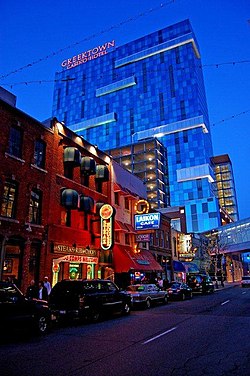Greektown Historic District
|
Greektown Historic District
|
|

Greektown at night
|
|
| Location |
Detroit, Michigan |
|---|---|
| Coordinates | 42°20′6″N 83°2′32″W / 42.33500°N 83.04222°WCoordinates: 42°20′6″N 83°2′32″W / 42.33500°N 83.04222°W |
| Architect | Multiple |
| Architectural style | Late Victorian, Renaissance, Romanesque |
| NRHP Reference # | 82002902 |
| Added to NRHP | May 06, 1982 |
Greektown is a historic commercial and entertainment district in Detroit, Michigan, located just northeast of the heart of downtown, along Monroe Avenue between Brush and St. Antoine Streets with a station on the city's elevated downtown elevated transit system known as the Detroit People Mover. Greektown is also situated between the Renaissance Center, Comerica Park, and Ford Field. The district is dominated by Greek-themed restaurants and includes St. Mary Roman Catholic Church, Second Baptist Church, the Athenium Suite Hotel, and the Greektown Casino Hotel within its boundaries. The district was listed on the National Register of Historic Places in 1982. The district is often the site of the Greek parade in March.
The area known today as Greektown was first settled in the 1830s by German immigrants, who created a primarily residential neighborhood in the area. However, in the earliest years of the 20th century, most of the German residents began moving from the neighborhood into areas further from downtown. As the Germans left the area, new Greek immigrants moved in, spurred by Theodore Gerasimos, the first documented Greek immigrant in Detroit. The newly arrived Greeks established businesses in the neighborhood.
By the 1920s, the area was becoming primarily commercial rather than residential, and the Greek residents began moving out; however, the restaurants, stores, and coffeehouses they established remained. The next thirty years brought a melange of immigrants to the few residential spaces left in the neighborhood. Redevelopment in the 1960s led to the neighborhood becoming more commercialized to provide space for municipal buildings and parking.
Realizing the culturally significant neighborhood was at risk, Detroit's Greek leaders banded together. With the help of the Mayor's office, the streetscape and building exteriors were improved, and additional street lighting was installed. The neighborhood threw a Greek festival in 1966, timed to coincide with Fourth of July celebrations. The festival was a success, and was continued for years until turnout grew too large. By that time, Greektown was firmly established in Detroit. The Greektown Historic District was listed on the National Register of Historic Places in 1982.
...
Wikipedia
